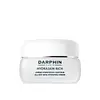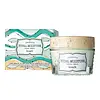What's inside
What's inside
 Key Ingredients
Key Ingredients

 Benefits
Benefits

 Concerns
Concerns

 Ingredients Side-by-side
Ingredients Side-by-side

Water
Skin ConditioningGlyceryl Stearate Se
EmulsifyingButyrospermum Parkii Butter
Skin ConditioningTridecyl Trimellitate
EmollientHydrogenated Polydecene
EmollientHydrogenated Polyisobutene
EmollientOlive Oil Decyl Esters
Butylene Glycol
HumectantPropanediol
SolventStearic Acid
CleansingSalicornia Herbacea Extract
Skin ConditioningLavandula Stoechas Extract
MaskingImperata Cylindrica Root Extract
Skin ConditioningMangifera Indica Fruit Extract
Skin ConditioningMangifera Indica Seed Butter
Skin ConditioningInulin
Skin ConditioningDimethicone
EmollientPalmitic Acid
EmollientTocopheryl Acetate
AntioxidantHydrogenated Vegetable Oil
EmollientPanthenol
Skin ConditioningGlycerin
HumectantCaprylic/Capric Triglyceride
MaskingPotassium Cetyl Phosphate
EmulsifyingCaprylyl Glycol
EmollientSqualene
EmollientCellulose Gum
Emulsion StabilisingCarbomer
Emulsion StabilisingOleic Acid
EmollientXanthan Gum
EmulsifyingPentaerythrityl Tetra-Di-T-Butyl Hydroxyhydrocinnamate
AntioxidantSodium Hydroxide
BufferingParfum
MaskingHydroxyisohexyl 3-Cyclohexene Carboxaldehyde
MaskingHexyl Cinnamal
PerfumingLimonene
PerfumingButylphenyl Methylpropional
PerfumingAlpha-Isomethyl Ionone
PerfumingLinalool
PerfumingHydroxycitronellal
PerfumingCitronellol
PerfumingBenzyl Benzoate
AntimicrobialCitral
PerfumingGeraniol
PerfumingTetrasodium EDTA
Sodium Benzoate
MaskingChlorphenesin
AntimicrobialPhenoxyethanol
PreservativeWater, Glyceryl Stearate Se, Butyrospermum Parkii Butter, Tridecyl Trimellitate, Hydrogenated Polydecene, Hydrogenated Polyisobutene, Olive Oil Decyl Esters, Butylene Glycol, Propanediol, Stearic Acid, Salicornia Herbacea Extract, Lavandula Stoechas Extract, Imperata Cylindrica Root Extract, Mangifera Indica Fruit Extract, Mangifera Indica Seed Butter, Inulin, Dimethicone, Palmitic Acid, Tocopheryl Acetate, Hydrogenated Vegetable Oil, Panthenol, Glycerin, Caprylic/Capric Triglyceride, Potassium Cetyl Phosphate, Caprylyl Glycol, Squalene, Cellulose Gum, Carbomer, Oleic Acid, Xanthan Gum, Pentaerythrityl Tetra-Di-T-Butyl Hydroxyhydrocinnamate, Sodium Hydroxide, Parfum, Hydroxyisohexyl 3-Cyclohexene Carboxaldehyde, Hexyl Cinnamal, Limonene, Butylphenyl Methylpropional, Alpha-Isomethyl Ionone, Linalool, Hydroxycitronellal, Citronellol, Benzyl Benzoate, Citral, Geraniol, Tetrasodium EDTA, Sodium Benzoate, Chlorphenesin, Phenoxyethanol
Water
Skin ConditioningDicaprylyl Carbonate
EmollientHydrogenated Lanolin
EmollientSqualane
EmollientGlycerin
HumectantMethyl Trimethicone
Skin ConditioningGlyceryl Stearate
EmollientStearyl Alcohol
EmollientPEG-8
HumectantPentylene Glycol
Skin ConditioningCaprylic/Capric/Succinic Triglyceride
EmollientCeteth-20
CleansingEthylhexyl Palmitate
EmollientDimethicone
EmollientBetaine
HumectantDecyloxazolidinone
AntimicrobialPhenoxyethanol
PreservativeCetyl Alcohol
EmollientPalmitic Acid
EmollientStearic Acid
CleansingParfum
MaskingSteareth-25
CleansingMangifera Indica Seed Butter
Skin ConditioningSteareth-21
CleansingTetrasodium EDTA
Tocopheryl Acetate
AntioxidantCarbomer
Emulsion StabilisingXylitylglucoside
HumectantSorbitol
HumectantLinalool
PerfumingAnhydroxylitol
HumectantSodium Hydroxide
BufferingAlgin
MaskingXylitol
HumectantHexyl Cinnamal
PerfumingLimonene
PerfumingPolyvinyl Alcohol
Cellulose Gum
Emulsion StabilisingTocopherol
AntioxidantBHT
AntioxidantWater, Dicaprylyl Carbonate, Hydrogenated Lanolin, Squalane, Glycerin, Methyl Trimethicone, Glyceryl Stearate, Stearyl Alcohol, PEG-8, Pentylene Glycol, Caprylic/Capric/Succinic Triglyceride, Ceteth-20, Ethylhexyl Palmitate, Dimethicone, Betaine, Decyloxazolidinone, Phenoxyethanol, Cetyl Alcohol, Palmitic Acid, Stearic Acid, Parfum, Steareth-25, Mangifera Indica Seed Butter, Steareth-21, Tetrasodium EDTA, Tocopheryl Acetate, Carbomer, Xylitylglucoside, Sorbitol, Linalool, Anhydroxylitol, Sodium Hydroxide, Algin, Xylitol, Hexyl Cinnamal, Limonene, Polyvinyl Alcohol, Cellulose Gum, Tocopherol, BHT
Ingredients Explained
These ingredients are found in both products.
Ingredients higher up in an ingredient list are typically present in a larger amount.
Carbomer is a polymer of acrylic acid. Its main role is to create a gel consistency.
A high amount of carbomer can cause pilling or balling up of products. Don't worry, most products contain 1% or less of carbomer.
Cellulose Gum is a water-soluble polymer that comes from cellulose. It is used to change the texture of a product and to help stabilize emulsions.
As an emulsifier, cellulose gum specifically thicken the texture of water-based products.
This ingredient is considered hypoallergenic and non-toxic. Cellulose Gum can be found in cosmetics, food, and other household goods such as paper products.
Learn more about Cellulose GumDimethicone is a type of synthetic silicone created from natural materials such as quartz.
What it does:
Dimethicone comes in different viscosities:
Depending on the viscosity, dimethicone has different properties.
Ingredients lists don't always show which type is used, so we recommend reaching out to the brand if you have questions about the viscosity.
This ingredient is unlikely to cause irritation because it does not get absorbed into skin. However, people with silicone allergies should be careful about using this ingredient.
Note: Dimethicone may contribute to pilling. This is because it is not oil or water soluble, so pilling may occur when layered with products. When mixed with heavy oils in a formula, the outcome is also quite greasy.
Learn more about DimethiconeGlycerin is already naturally found in your skin. It helps moisturize and protect your skin.
A study from 2016 found glycerin to be more effective as a humectant than AHAs and hyaluronic acid.
As a humectant, it helps the skin stay hydrated by pulling moisture to your skin. The low molecular weight of glycerin allows it to pull moisture into the deeper layers of your skin.
Hydrated skin improves your skin barrier; Your skin barrier helps protect against irritants and bacteria.
Glycerin has also been found to have antimicrobial and antiviral properties. Due to these properties, glycerin is often used in wound and burn treatments.
In cosmetics, glycerin is usually derived from plants such as soybean or palm. However, it can also be sourced from animals, such as tallow or animal fat.
This ingredient is organic, colorless, odorless, and non-toxic.
Glycerin is the name for this ingredient in American English. British English uses Glycerol/Glycerine.
Learn more about GlycerinHexyl Cinnamal is a fragrance ingredient with a similar scent to jasmine. It can be naturally found in chamomile essential oil.
This ingredient is a known EU allergen and may sensitize the skin. The EU requires this ingredient to be listed separately on an ingredients list.
Hexyl Cinnamal is not water soluble but is soluble in oils.
Learn more about Hexyl CinnamalLimonene is a fragrance that adds scent and taste to a formulation.
It's found in the peel oil of citrus fruits and other plants such as lavender and eucalyptus. The scent of limonene is generally described as "sweet citrus".
Limonene acts as an antioxidant, meaning it helps neutralize free radicals.
When exposed to air, oxidized limonene may sensitize the skin. Because of this, limonene is often avoided by people with sensitive skin.
The term 'fragrance' is not regulated in many countries. In many cases, it is up to the brand to define this term. For instance, many brands choose to label themselves as "fragrance-free" because they are not using synthetic fragrances. However, their products may still contain ingredients such as essential oils that are considered a fragrance.
Learn more about LimoneneLinalool is a fragrance and helps add scent to products. It's derived from common plants such as cinnamon, mint, citrus, and lavender.
Like Limonene, this ingredient oxidizes when exposed to air. Oxidized linalool can cause allergies and skin sensitivity.
This ingredient has a scent that is floral, spicy tropical, and citrus-like.
Learn more about LinaloolMangifera Indica Seed Butter isn't fungal acne safe.
Palmitic Acid is a fatty acid naturally found in our skin and in many plant and animal sources. In cosmetics, it is usually derived from palm oil. It serves many purposes in skincare, acting as a cleanser, emollient, and emulsifier.
As an emollient, palmitic acid helps soften and smooth the skin by preventing water loss. In cleansers, it helps remove oil and dirt while creating foam.
Its emulsifying properties help stabilize products by keeping water and oil-based ingredients from separating.
This may not be suitable for fungal acne-prone skin, as fatty acids like this can sometimes trigger breakouts in sensitive individuals.
Learn more about Palmitic AcidParfum is a catch-all term for an ingredient or more that is used to give a scent to products.
Also called "fragrance", this ingredient can be a blend of hundreds of chemicals or plant oils. This means every product with "fragrance" or "parfum" in the ingredients list is a different mixture.
For instance, Habanolide is a proprietary trade name for a specific aroma chemical. When used as a fragrance ingredient in cosmetics, most aroma chemicals fall under the broad labeling category of “FRAGRANCE” or “PARFUM” according to EU and US regulations.
The term 'parfum' or 'fragrance' is not regulated in many countries. In many cases, it is up to the brand to define this term.
For instance, many brands choose to label themselves as "fragrance-free" because they are not using synthetic fragrances. However, their products may still contain ingredients such as essential oils that are considered a fragrance by INCI standards.
One example is Calendula flower extract. Calendula is an essential oil that still imparts a scent or 'fragrance'.
Depending on the blend, the ingredients in the mixture can cause allergies and sensitivities on the skin. Some ingredients that are known EU allergens include linalool and citronellol.
Parfum can also be used to mask or cover an unpleasant scent.
The bottom line is: not all fragrances/parfum/ingredients are created equally. If you are worried about fragrances, we recommend taking a closer look at an ingredient. And of course, we always recommend speaking with a professional.
Learn more about ParfumPhenoxyethanol is a preservative that has germicide, antimicrobial, and aromatic properties. Studies show that phenoxyethanol can prevent microbial growth. By itself, it has a scent that is similar to that of a rose.
It's often used in formulations along with Caprylyl Glycol to preserve the shelf life of products.
Sodium Hydroxide is also known as lye or caustic soda. It is used to adjust the pH of products; many ingredients require a specific pH to be effective.
In small amounts, sodium hydroxide is considered safe to use. However, large amounts may cause chemical burns due to its high alkaline.
Your skin has a natural pH and acid mantle. This acid mantle helps prevent harmful bacteria from breaking through. The acid mantle also helps keep your skin hydrated.
"Alkaline" refers to a high pH level. A low pH level would be considered acidic.
Learn more about Sodium HydroxideStearic Acid is a fatty acid. It is an emollient, emulsifier, and texture enhancer.
As an emollient, stearic acid helps soften skin. It aids the skin's protective barrier by preventing water loss. It also provides a gentle cleansing effect without stripping away natural oils.
Stearic acid may also be used to enhance the texture of products. It can add volume and stabilize ingredients such as water and oil. This can help water and oil ingredients from separating.
Sources of stearic acid include animal or vegetable fats/oils such as coconut or shea. It can be naturally found in butter, cocoa butter, shea butter, vegetable fats, and animal tallow.
This ingredient may not be Malassezia folliculitis, or fungal-acne safe.
Learn more about Stearic AcidTetrasodium EDTA is the salt formed from neutralizing ethylenediamine tetraacetic acid with sodium hydroxide. It is a chelating agent and used to prevent metal ions from binding to other ingredients. This helps keep the product and ingredients stable.
Tetrasodium EDTA comes as a white solid and is soluble in water.
Tocopheryl Acetate is AKA Vitamin E. It is an antioxidant and protects your skin from free radicals. Free radicals damage the skin by breaking down collagen.
One study found using Tocopheryl Acetate with Vitamin C decreased the number of sunburned cells.
Tocopheryl Acetate is commonly found in both skincare and dietary supplements.
Learn more about Tocopheryl AcetateWater. It's the most common cosmetic ingredient of all. You'll usually see it at the top of ingredient lists, meaning that it makes up the largest part of the product.
So why is it so popular? Water most often acts as a solvent - this means that it helps dissolve other ingredients into the formulation.
You'll also recognize water as that liquid we all need to stay alive. If you see this, drink a glass of water. Stay hydrated!
Learn more about Water